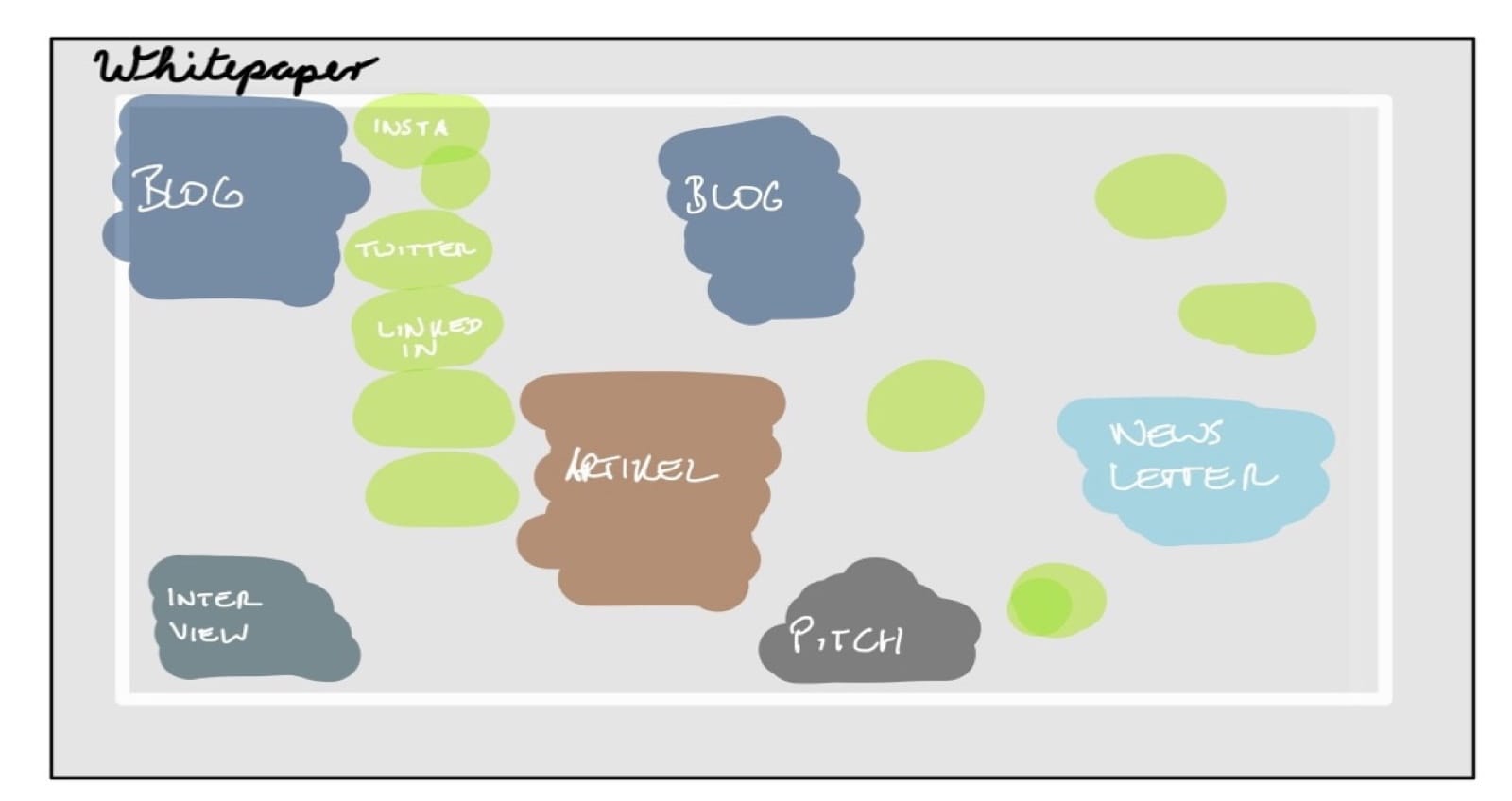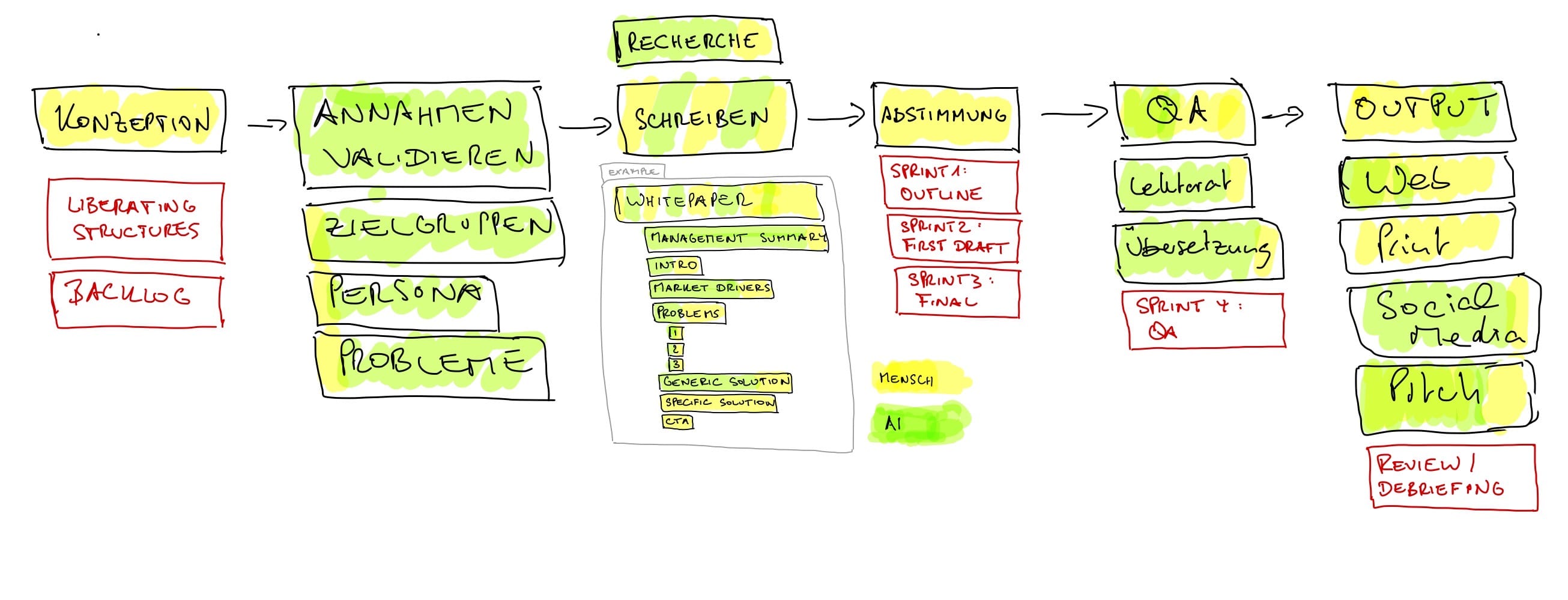The Optimal White Paper for Your Customers
When it comes to communicating complex ideas, hastily thrown together information just won’t cut it. That’s where the trusty “white paper” comes in. But what if I told you there’s a better way to create white papers? By using an agile approach and AI-assisted tools, we can quickly and deeply understand complex topics, allowing us to create top-notch white papers that provide nourishing substance for your audience.
The white paper is the original form of long-form content. Once resembling thick phone books (hence the name), dominated by dense blocks of text with dreadful passive constructions, white papers have become more modern and accessible in recent years. Offering a good white paper that presents content in an appealing manner, at the appropriate level of depth for the target audience and in a clear and understandable language, sets you apart from competitors and facilitates the decisions of potential customers.
Many white papers are created unnoticed in the depths of a specialized department. While the communication department churns out one blog and social media post after another, experts spend months delving deeper into the subject matter. Eventually, the white paper is completed, printed, promoted with a single social media article, and then consigned to the analog and digital archive to gather dust. What a shame!
This is not only an incredible waste of time and money, but a huge potential remains untapped. Because the white paper is the secret star of your content strategy!
What if you were to generate target-group-specific content and presentations during the creation of the white paper, which contribute to an overarching communication strategy?
White papers as the centerpiece of your communication - your advantages:
- Occupy strategic topics with substantive depth to provide decision-makers with more arguments for buying your product or service and to set yourself apart from competitors.
- Set long-term impulses with valuable content to deepen the relationship with your target groups. Establish a clear communication with your target audience to gain more trust from your customers.
- Demonstrate thought leadership to be perceived by your customers as an innovative, high-quality, and future-proof company.
- Synchronize marketing and sales activities to generate more business with a common goal.
What is special about my approach is the focus on an agile process: It is not just about “flexibility,” but about “courage” (getting to the heart of the matter, no hiding behind hackneyed phrases), “openness” (being able to tolerate and address critical questions from the customer’s perspective), “respect” (aiming at eye level), “conscientiousness” (details are the spice of life!), and focus (benefit, benefit and deadlines, deadlines!). To make progress efficiently, I use agile methods and artificial intelligence tools.
Writing a white paper should not be a tedious duty and effort; it creates a deeper understanding of communication with customers, without which your salary cannot be paid.
From the outset with transparency and a clear strategy
The process to your white paper
When creating a white paper, we follow tried and tested steps:
1. Onboarding: Motivation, target audience, content, formats**
First things first: an effective white paper requires time. And a lot of brainpower. Because only a white paper that actually solves a problem for the target audience (or provides a guide and recommendation for doing so) will have the desired effect. Anything else would be a waste of (life)time for the reader and even more so for us.
That’s why we take enough time for onboarding. Together, we assess why you are writing a white paper for whom and what you want to achieve with it and when. To do this, we need to know exactly what your reader already knows and what is needed. A clear focus on the essentials is important here.
2. Defining and Validating Contents
After comparing your offer and core messages (if any - we will also handle this), we create an initial outline for the whitepaper. In my experience, it is worth spending more time refining the outline so that we know exactly which direction we are heading and which content is still missing and needs to be gathered.
It is your - and my - precious time: that’s why we validate our assumptions using artificial intelligence.
3. Writing: Outline, Management Summary, and Deep Content
If you are satisfied with the outline (and now would be a good time to discuss the outline with people who will see or approve it later), we will develop the content in several “informal interviews” via video conference. “Informal” means that I will ask questions to extract the relevant knowledge from your perspective for the whitepaper. Think of me as a kind of “sparring partner” or as a “representative for your readers/customers.”
Often, only after a few interviews does the actual core theme of the whitepaper emerge. We formulate the essence of this in the “management summary.” It doesn’t have to be a perfect match yet, but the management summary guides us through the rest of the whitepaper. Now we need to validate the statements listed in the management summary with specific content and facts in the whitepaper. At this point, we should have already thought enough to create a first “elevator pitch” from it. This work brings us further focus for the rest of the whitepaper.
To find the topics and to validate our assumptions of your ideal reader, we will use AI tools to write more specifically for the target audience and to know exactly where you bring added value to the readers with your specific experience. The use of AI helps us to reach our goal faster and improve the content.
4. Refining: Elegant Whitepaper Tango
In the next step, we work on the content of the whitepaper. Since we are agile, we choose the chapters and parts that bring the most benefit to your readers. From this, we can already create the first (blog) articles or LinkedIn long-form posts if you like. The advantage is that we can incorporate the feedback from the readers into the next version of the whitepaper. This way, we further increase the value of the whitepaper and position the topic with your target audience.
We will dance together for some time: I write as much as possible, share the document with you, and ask for your questions and suggestions. Then it’s your turn. You give me more information, maybe we also exchange briefly by video, and we move forward stimulated and relaxed towards our goal. Along the way, there will be opportunities to create blog posts or social media postings. You decide if you want to do that.
Optional: Layout and Graphics
So far, we have only discussed the text. Of course, the whitepaper should also be visually appealing. That’s why I recommend working on graphics during the content creation process. I enjoy creating sketches and to visualize unexpected connections. Depending on your setup, I support your graphics and design department with briefings (if you want to do it in-house), but I also offer you a publishable whitepaper in collaboration with an experienced graphic designer according to your corporate identity.
5. Celebrating Success: Whitepaper with Impact
At the end of our collaboration, you will not only have a whitepaper for your archive but will have also published several articles and social media posts, created a 5-minute PowerPoint pitch, and a PowerPoint sales deck.
 Of course, we always have the published whitepaper in mind…
Of course, we always have the published whitepaper in mind…
 … but “agile” means that we create additional content on our way to the final version of the whitepaper. This saves you time, effort and money - more bang for the buck!
… but “agile” means that we create additional content on our way to the final version of the whitepaper. This saves you time, effort and money - more bang for the buck!
Our Collaboration
Well-conceived and carefully crafted white papers are valuable content sources for long-term campaigns and sales initiatives. The content is exclusive and valuable to your target audience. Therefore, you don’t have to chase trends but set the tone with your content.
I would like to support you with the following advice and assistance:
1. Free and Non-binding Consultation: Share your motivation and expectations, and I will provide my assessment. Book an appointment now to get to know each other.
2. Onboarding: Define target audiences, core messages, story, content, and formats, align timelines, and establish collaboration.
3. Outline and Management Summary Development: Validate and consolidate assumptions through informal interviews and content research.
4. Communication Plan Development: Provide an overview of accompanying measures and long-term campaigns.
5. Whitepaper and Other Content Creation: Agile approach, uncomplicated coordination, and optional graphic and layout support.
6. Campaign Launch Support: Provide additional content for pitches, brochures, articles, blogs, and social media posts for the long-term.
You may be wondering why you should work with me for this project…
My name is Reiner Gärtner, and I have been working as a freelance journalist, copywriter, project manager, coach, consultant, and Agile Scrum Master for over 25 years. During this time, I have written countless articles, brochures, presentations, social media posts, and whitepapers for large B2B companies. If there was a “super skill,” it is the ability to quickly and deeply understand complicated and complex topics. I enjoy working in the thematic areas of technology and IT, finance, and energy.
I live with my family on Awabakal land in Lake Macquarie, and would be looking for clients in the Hunter, Newcastle, Central Coast and down to Sydney.
Connect with me via LinkedIn or contact me.
I am looking forward to a productive and relaxed collaboration!


